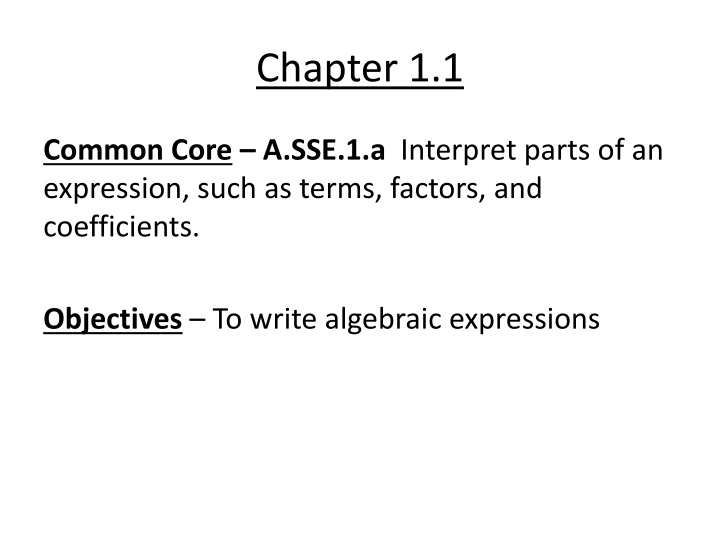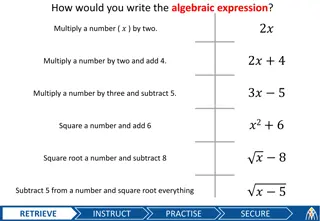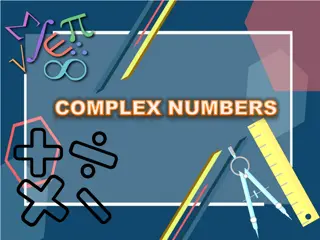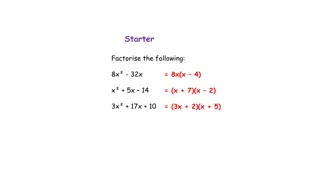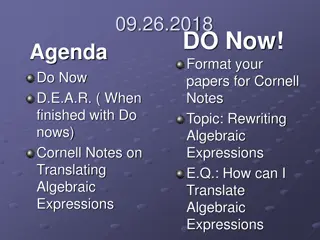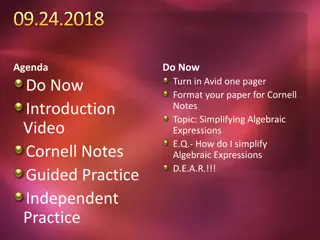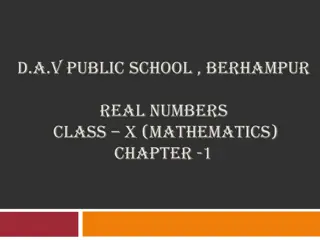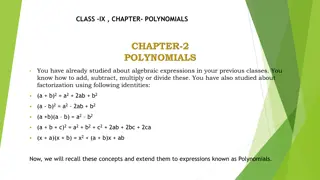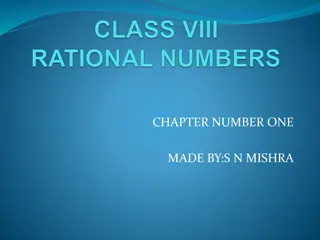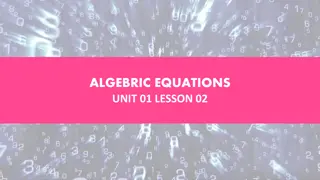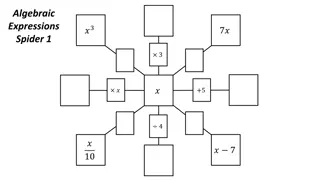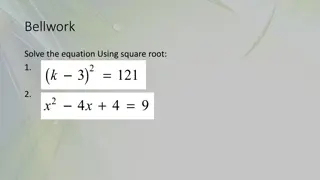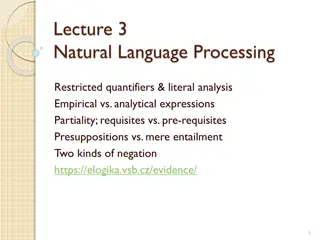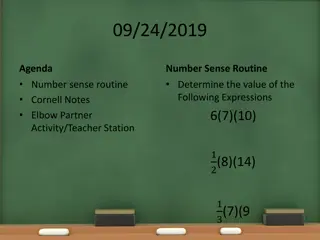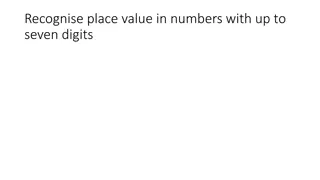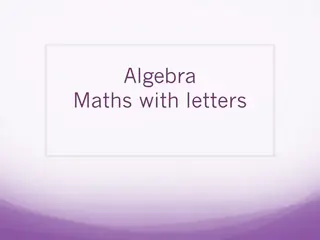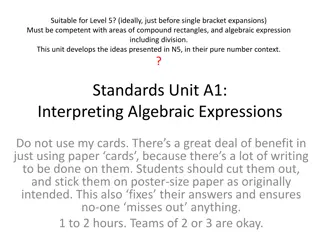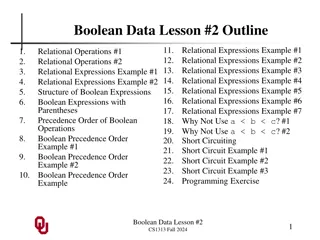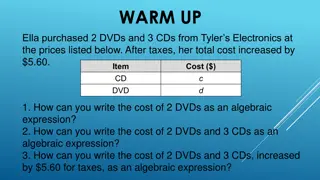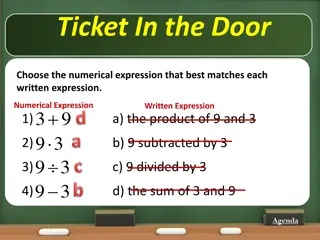Algebraic Expressions and Numbers
Delve into the world of algebra with a focus on interpreting expressions, identifying parts of an expression, and understanding the significance of variables. Explore concepts like quantities, variables, algebraic and numerical expressions, exponents, order of operations, rational and irrational numbers, along with their properties and operations. Enhance your mathematical knowledge through detailed explanations, examples, and visuals for a comprehensive learning experience.
Download Presentation

Please find below an Image/Link to download the presentation.
The content on the website is provided AS IS for your information and personal use only. It may not be sold, licensed, or shared on other websites without obtaining consent from the author.If you encounter any issues during the download, it is possible that the publisher has removed the file from their server.
You are allowed to download the files provided on this website for personal or commercial use, subject to the condition that they are used lawfully. All files are the property of their respective owners.
The content on the website is provided AS IS for your information and personal use only. It may not be sold, licensed, or shared on other websites without obtaining consent from the author.
E N D
Presentation Transcript
Chapter 1.1 Common Core A.SSE.1.a Interpret parts of an expression, such as terms, factors, and coefficients. Objectives To write algebraic expressions
Ch 1.1 Notes Quantity is anything that can be measured or counted. Variable is a symbol, usually a letter, that represents the value of a variable quantity. Algebraic Expression is a mathematical phrase that includes one or more variable. Numberical Expression is a mathematical phrase involving numbers and operation symbols, but no variables.
+ - * /
Chapter 1.2 Common Core A.SSE.1.a Interpret parts of an expression, such as terms, factors, and coefficients. Objectives To simplify expressions involving exponents. To use the order of operations to evaluate expressions.
Ch 1.2 Notes Power has two parts, a base and an exponent. Exponent tells you how many times to sue the base as a factor. Base is the number that is multiplied repeatedly. ?? Simplify a numerical expression when you replace it with its single numerical value. Evaluate an algebraic expression by replacing each variable with a given number and then simplify it
Order of Operations Please Excuse My Dear Aunt Sally -
Chapter 1.3 Common Core N.RN.3 Explain why the sum or product of two rational numbers is rational; that the sum of a rational number and an irrational number is irrational. Objectives To classify, graph, and compare real numbers. To find and estimate square roots.
Ch 1.3 Notes Radical symbol ? Radical is both the radical symbol and the radicand Radicand Set is a well-defined collection of objects. Each object is called an element of the set. Subset consists of element form the given set.
Rational Numbers - Integers - Whole Numbers - Natural Numbers -
Irrational Numbers REAL NUMBERS are both rational and irrational numbers. < - less than > - greater than < - less than or equal to > - greater than or equal to
Chapter 1.4 Common Core N.RN.3 Explain why the sum or product of two rational numbers is rational; that the sum of a rational number and an irrational number is irrational. Objectives To identify and use properties of real numbers.
Ch 1.4 Notes Commutative Properties of Addition or Multiplication a + b = b + a a * b = b * a Associative Properties of Addition or Multiplication (a + b) = c = a + (b + c) (a * b) * c = a * (b * c)
Identity Properties of Addition or Multiplication a + 0 = a a * 1 = a Zero Property of Multiplication a * 0 = 0 Multiplication Property of -1 a * -1 = -a
Deductive Reasoning is the process of reasoning logically form given facts to a conclusion. Counterexample is and example showing that a statement is false.
Chapter 1.5 Common Core N.RN.3 Explain why the sum or product of two rational numbers is rational; that the sum of a rational number and an irrational number is irrational. Objectives To find the sums and differences of real numbers.
Ch 1.5 Notes Absolute Value Adding Numbers with the Same Sign 3 + 4 = ____ -3 + -4 = ____ Adding Numbers with Different Signs 3 + -4 = ____ -3 + 4 = ____
Opposites Additive Inverses 5 & -5 are additive inverses of each other. Inverse Property of Addition 5 + -5 = 0 Subtracting Real Numbers 3 (-5) = _____
Chapter 1.6 Common Core N.RN.3 Explain why the sum or product of two rational numbers is rational; that the sum of a rational number and an irrational number is irrational. Objectives To find the products and quotients of real numbers.
Ch 1.6 Notes Multiply and Dividing Real Numbers Positive # * Positive # = Positive # Negative # * Negative # = Negative # Positive # *Negative # =Negative # Negative # * Positive # =Negative #
Multiplicative Inverse 1 5 5= 1
Chapter 1.7 Common Core A.SSE.1.a Interpret parts of an expression, such as terms, factors, and coefficients. Objectives To use the Distributive Property to simplify expressions.
Ch 1.7 Notes Distributive Property a(b + c) = _________ a(b - c) = _________
Term is a number, a variable, or the product of a number on one or more variables. Constant is a term that has no variable. Coefficient is the number in front of a variable. Like Terms have the same variable factors so you can put them together.
Chapter 1.8 Common Core A.CED.1. Create equations and inequalities in one variable and use them to solve problems. Objectives To solve equations using tables and mental math.
Ch 1.8 Notes Equation is a mathematical sentence that uses an equal sign (=). Open Sentence is an equation that contains one or more variables and may be true or false depending on the values of the variables.
Chapter 1.9 Common Core A.REI.10 & A.CED.2 Understands that the graph of an equation in two variables is the set of all its solutions plotted in the coordinate plane, often forming a curve. Objectives To use tables, equations, and graphs to describe relationships.
Ch 1.9 Notes Solution of an equation containing a variable is a value of the variable that makes the equation true. Inductive Reasoning is the process of reaching a conclusion based on an observed pattern.
